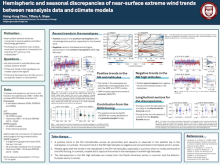Hemispheric and seasonal discrepancies of near-surface extreme wind trends between reanalysis data and climate models
Hsing-Hung
Chou
Department of Geophysical Sciences, The University of Chicago
Poster
Near-surface zonal wind extremes are connected to severe weather and affect wind energy generation. Previous studies showed climate models predict an increase in the frequency of extreme near-surface winds by the end of the 21st century in the midlatitudes of both hemispheres. However, recent trends in near-surface extreme winds defined by the daily wind distribution have not been documented. Here we compare satellite-era trends of near-surface extratropical wind extremes in reanalyses and models participating in the Coupled Model Intercomparison Project Phase 6 (CMIP6). Our results reveal that extreme near-surface westerlies (>99th percentile) have significantly weakened in the Northern Hemisphere in reanalysis data, particularly during winter on the flanks of the climatological jet. However, there is a discrepancy between the distribution of the trends in the models and the trends in the reanalyses. In contrast, extreme near-surface westerlies in the Southern Hemisphere have significantly strengthened throughout the seasonal cycle in the reanalyses around the climatological jet position. However, a discrepancy between the trends in the CMIP6 models and reanalyses is evident in winter, but not in summer. Models also capture the significant weakening of extreme near-surface easterlies (< 1st percentile) seen in the Southern Hemisphere in reanalysis data. Overall, our results highlight extreme near-surface winds have changed significantly over the satellite era with models only capturing some of these changes. Future work will focus on understanding the cause of the trends including their connection to anthropogenic forcing.

Poster file
chou-hsing-hung-confronting-poster.pdf
(2.33 MB)
